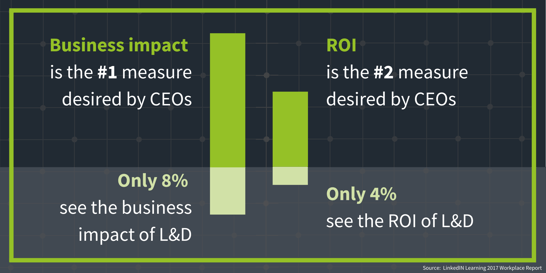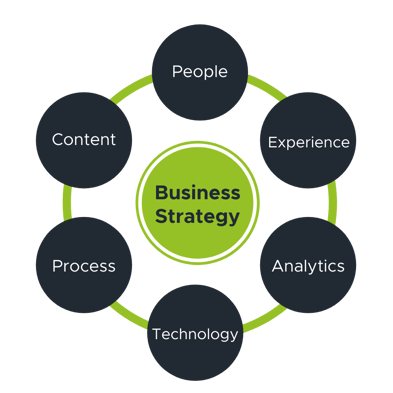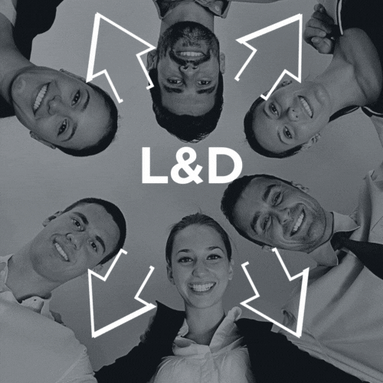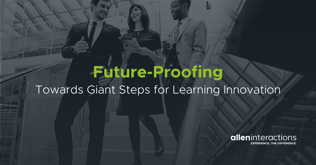Blog
Future Proofing: Towards Giant Steps For Learning Innovation
If we want to do things differently, we need to start thinking differently.


Future-Proofing Your Organization Through Learning And Development
By Michael Hruska and Daniel McCoy | April 02, 2020 | Custom Learning | 0 Comments
If we want to do things differently, we need to start thinking differently.
What Is Going on?
The business landscape is shifting faster than ever. Technology acceleration in areas like Mobile, the Internet of Things (IoT), VR, and AI will continue to disrupt most marketplaces. In addition to this combinatorial innovation, exponential growth organizations like Uber and AirBnB are shifting markets in unprecedented ways.
The question is: What is going to disrupt your company's position, and what (if anything) can you do about it?
Inside most organizations, there is another chapter to the story. 90% of business leaders believe that L&D programs are the key to closing skill gaps. But only 8% of CEOs say they actually see the business impact of their Learning and Development (L&D). Fewer (<4%) see a clear Return on Investment (ROI).

Simultaneously, L&D has its own challenges. These include the reactive, rather than the proactive use of training; the difficulty in getting management buy-in for new learning initiatives; the business not making time for training; and the complexity of implementing new learning technologies. There is also the challenge of aligning training outcomes to measures of effectiveness and engagement. Here are some recent results from a crowdsourced kiosk at ATD’s ICE conference in May 2019.
.png?width=674&name=Source_%20LinkedIN%20Learning%202017%20Workplace%20Report%20(1).png)
The Center for Management & Organization Effectiveness (CMOE) also has their own Top 10 list of challenges facing L&D. They identified the number one challenge as “dealing with change”. Given the external impact of emerging technologies, the necessary and inevitable internal changes in any organization will only continue to exacerbate this challenge.
A recent survey from HR.com on the effectiveness of Learning Solutions discovered that only 16.5% of people strongly agree that L&D in their organization excellent. How can you help or even get started when this is the case?
Emerging Thinking
First, the good news is that C-level and Chief Strategy Officers are taking a hard look at where their businesses need to go. They are generally aware of impending market shifts and the inevitability of change.
It is the perfect time for L&D to align the learning function with organizational outcomes and emerging business strategies. Doing so will require a deliberate, persistent, and incremental approach. This journey will also require new ways of thinking and improved toolkits.
Many organizations have taken on "Agile" and "Digital Transformation" initiatives—both positive moves towards a more future proofed organization. However, other than delivering training content, these corporate wide projects are generally not tightly coupled with learning and development. Read more on this in an article in Forbes “Companies are Lagging Behind When It Comes to Digital Transformation”.
But, what if the L&D function transformed in ways that would provide a competitive advantage to the business? What if L&D could move beyond its current position to be seen as a highly strategic advantage for the business itself?
You might assume that your organization has come to realize (or will soon) that:
- People are the most important resource in an organization
- Investing in growing and developing people should be a business imperative
- This investment will make a difference across the business from morale and tenure to business transformation
These fundamental requirements for survival are in different stages of evolution for any organization. Where does your organization sit? What does the C-Suite believe?
Adapting these core tenets will be paramount to success. Yet, moving to belief and adoption is just the first step.
New Models
If we want to do things differently, then we need to start thinking differently. This means we need some new models.
First, ecosystems thinking is critical. By this I mean that we need to consider our Learning and Performance Ecosystem. This is a holistic approach where people, process, content, experiences, measurement, and analytics are aligned with business strategy and supported by technology. Here is some additional reading on Learning Ecosystems thinking and design.

Second, we need a new metaphor for how we think about L&D and its relationship to the organization itself. If people are the most important part of the organization and they and their development are valued, we might consider them the "hardware" of the organization. The "software" that our people run is distributed by the output, or "software update" from L&D and corporate communications.

Taking this a bit further, we should start to think about how L&D functions for the overall organization itself. If we imagine the organization as an organism, then we might consider L&D as the central nervous system. In that function, L&D can sense a variety of changes and needs, augmenting the "software" updates to the elements of the organism in order to ensure that those elements are operating at optimal levels.
The move from flexible to agile is transformational for organizations. An agile organization can stretch, move quickly, fail fast, and recover. But is that enough? Should we also be thinking about how our organization can be truly adaptive?
An adaptive organization is flexible and agile, senses deeply, and can respond quickly to changes. An adaptive organization espouses both agile and lean thinking and seeks opportunities for advancement without fear of failure.
.png?width=631&name=Services%20-%20blog%20graphics%20future%20proofing%20(1).png)
So What Is an “Adaptive Learning Organization?”
You've probably heard of adaptive learning by now. Adaptive learning systems emerged from intelligent tutoring research. These systems adapt content and tailor it to the individual learner needs. We are talking about something different here when we refer to an "adaptive learning organization".
An adaptive learning organization is an organization that models ecosystems thinking, acts like a central nervous system, and provides the connectivity for the business to sense, respond, and adapt continuously.
Thinking beyond agile and towards an open adaptive learning organization means more than using Design Thinking or believing that people are our greatest asset. It means that we consider a new set of principles for our L&D function and across the organization.
An Adaptive Learning Organization should have the 10 following guiding principles:
| Principle | Explanation |
| Putting People First | Development of people is viewed as an imperative. Conversations, thoughtful investments, and measurements that target the appropriate level of people development are the top priority across the entire organization. |
| Ecosystems Thinking | Organizations are complex. In order to serve them, we need to think of them as value-driven ecosystems. In our organization, we think about developing people in terms of connections, resources, and journeys. We actively seek to evolve and align the elements of the learning ecosystem growth mindset. |
| Connective Collaboration | Connected and trusted collaboration is critical. Our L&D function catalyzes unfettered and open collaboration across the organization. We nurture personal trust to grow organizational trust. |
| Purpose-Driven Design | Purpose is a necessary component of every effort in an ecosystem. We pursue purpose using empathy and design thinking to bring the greatest impact to the business and its people. |
| Problem Seeking | Thoughtful problem articulation is critical to maintaining adaptive ecosystems. Our focus is identifying and prioritizing problems through the careful consideration of business outcomes. This is emphasized more than than solution design itself. |
| Data-Informed Strategy | Executing data-informed strategies with increasing fidelity is critical to an adaptive learning organization. Strategies are informed by the analysis and exploration of the data footprint of learning activity, behaviors, and outcomes. Data and meaningful partnerships with SMEs, processes, and statistics are used to plan initiatives based on their ROI. |
| Valued Perception of L&D | L&D functions as the central nervous system for the business. The free flow of information to and from the learning organization fosters valued business outcomes. |
| Ideas and Feedback | New ideas and feedback are required to accelerate development of solutions. Our L&D organization catalyzes and propagates a free flow of information and ideas. We seek feedback and evaluate data constantly without fear of failure. |
| Focus on Outcomes | Being busy and being productive are not equivalent. Our team seeks to impact positive change rather than reflexively treat the symptoms of deeper problems. |
| Technology is Just One Component | Technology is a tool and a component of a learning ecosystem. But it is not the solution for every problem. Our organization values the alignment of people, process, experiences, and analytics. All of which are underpinned by technology in direct support of business strategy. |
These items are key principles of an adaptive learning organization that is positioned to create transformative effects for their overall organization. These principles should serve as a guiding framework for your L&D work to begin to understand where you might be in the framework to work towards a better future state.
Where do you rate on a red/yellow/green for each? Use this scorecard with your team to get an understanding of the starting point for your potential journey towards an adaptive learning organization.
Beyond these principles are tools and methodologies that you can introduce to your world to start to move along this journey.
Download your Future-Proofing Resource toolkit now to access complimentary resources like:
- Learning Ecosystem Canvas
- Learning Ecosystem Innovation Building Blocks
- Adaptive Learning Organization Scorecard
- Webinar: Elements of the Learning Ecosystem Canvas
- White Paper: How Adaptive Learning Organizations Improvise and Innovate in the Face of Rapid Change
About the Author: Michael Hruska and Daniel McCoy
Comments
Would you like to leave a comment?
Related Blog Posts

By: Michael Hruska and Daniel McCoy | Apr, 2020
Category: Custom Learning, Strategic Consulting
.png?width=316&name=2023%20Blog%20Covers%20and%20In-Line%20Graphics%20(9).png)
Blog
3 Steps to Becoming an Adaptive Learning Organization
If we want to do things differently, we need to start thinking differently.
By: Michael Hruska and Daniel McCoy | Feb, 2023
Category: Custom Learning, Strategic Consulting

Blog
Enabling an Empowered Distributed Workforce
If we want to do things differently, we need to start thinking differently.
By: Michael Hruska and Daniel McCoy | Apr, 2020
Category: Custom Learning

